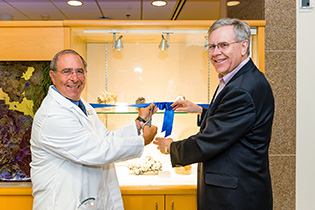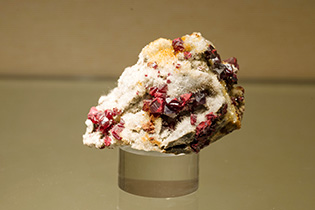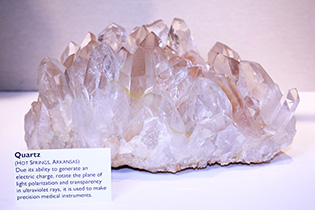Medicine Rocks
“Minerals in Medicine” Exhibit at Clinical Center

PHOTO BY ANDREW PROPP
The “Minerals in Medicine” exhibit opened at the NIH Clinical Center in September with a ribbon-cutting ceremony by John Gallin, director of the CC, and Jeffrey Post, chair of the Department of Mineral Sciences and curator of the National Gem and Mineral Collection at the Smithsonian Institution National Museum of Natural History.
The NIH Clinical Center (CC), in partnership with the Smithsonian Institution, held a ribbon-cutting ceremony September 12 for a new “Minerals in Medicine” exhibition showcasing more than 40 minerals crucial to human health and biomedicine. The minerals will be on display for 18 months.
On loan from the National Museum of Natural History, the exhibit’s crystals and minerals, are not only interesting to admire but also educational in that they allow spectators to learn about their important roles in keeping the human body healthy. The minerals enable the creation of life-saving medicines and cutting-edge medical equipment used in the CC and health-care facilities worldwide.
“This exhibit is a product of a great partnership between Jeffrey Post and his colleagues at the Smithsonian’s Museum of Natural History and the NIH Clinical Center,” said CC Director John Gallin. “It is really a treat to be able to display the natural beauty of these magnificent crystals that contain elements vital to human health. We hope our staff, visitors, and patients smile when looking at these miracles of nature.”
The exhibit, prominently placed near Admissions on the first floor, is seen by hundreds of people each day. Bob Range, a hospital dentist with the National Institute of Dental and Craniofacial Research who works in the Clinical Center, recently visited the exhibit and was particularly interested in the minerals used in dentistry, including gypsum, calcite with marcasite, and fluorapatite with calcite.
“Naturally occurring stones and minerals have long been an essential staple of dental materials—allowing providers to clean and strengthen teeth, create anatomical restorations, and pour impressions in stone to fabricate removable and fixed prostheses,” said Range. “It is quite remarkable to see some of these materials on display in their unprocessed organic form. The stones are stunning.”
Similarly, Dennis Johnson, a computerized tomography (CT) technologist in the CC Radiology and Imaging Sciences Department, enjoyed viewing the hübnerite with quartz (from Pasto Bueno, Peru), which is used in CT imaging.
“The minerals are absolutely gorgeous and intriguing,” said Johnson. “The hübnerite with quartz is very fascinating to see. This is source of tungsten in it rawest form. Tungsten is used in the target of the anode portion of an X-ray tube (located in a CT scanner). It is imbedded in a copper block, which is the part of the X-ray tube bombarded by the electron beams to produce x-rays.”
Some of the Minerals on Display
Minerals and metals are critical for many of the technologies that define our modern medical world and are key to today’s biomedical enterprise. They are used as sources or components of drugs and devices, and they are key to innovative technologies. The items in this display are some examples of crystals and minerals critical to keeping ourselves and our bodies healthy and functioning normally and are also key in past, present, and future technologies.

PHOTO BY ANDREW PROPP
Cinnabar with Quartz (Kyrgyzstan): The common bright scarlet to brick-red form of mercury sulfide. Mercury amalgam is used in glass thermometers and has been used for over 150 years in tooth fillings.

PHOTO BY ANDREW PROPP
Quartz (Hot Springs, Arkansas): Due to its ability to generate an electric charge, to rotate the plane of light polarization, and to be transparent in ultraviolet rays, it is used to make precision medical instruments.

PHOTO BY ANDREW PROPP
Rhodonite (Minas Gerais, Brazil): Contains manganese, a trace essential mineral for human health. It helps our bodies make DNA and RNA, breaks down food into energy, and heals wounds.
This page was last updated on Tuesday, April 12, 2022
